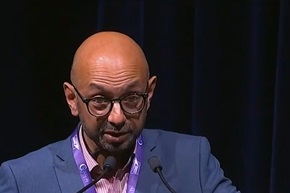
“It’s rare to see a single trial kill something that was greeted with enthusiasm, so the question is why is renal denervation alive again? The answer is new information.” These were the words of Lindsay Machan (The University of British Columbia, Vancouver, Canada) at the 2024 Charing Cross (CX) International Symposium (23–25 April, London, UK), presenting in a session which discussed developing evidence in support of the retired techniques’ unanticipated return.
Speaking first, Neelan Das (East Kent Hospitals University NHS Foundation Trust, London, UK) detailed the influential trial—SYMPLICITY HTN-3 (Renal denervation in patients with uncontrolled hypertension)— which, in 2014, found no significant difference between renal denervation and sham control groups at six-month follow-up published in The New England Journal of Medicine (NEJM).
“Renal denervation was—up to now—effectively abandoned,” Das said. “Yet, looking at three-year follow-up data from the SYMPLICITY HTN-3 trial published in 2022, the evidence suggested there was merit to renal denervation, and that’s with the first-generation single-electrode technology.”
Since then, the second generation, multi-electrode technology and ultrasound renal denervation techniques have also shown significant reduction in blood pressure compared to sham control groups, Das explained. Exemplifying this, Das quoted the RADIANCE II trial results—the largest trial comparing ultrasound renal denervation to a sham control—and highlighted the statistically significant improvement in blood pressure in patients who were taken off antihypertensive medication for four weeks, with a sustained benefit at night to prevent the deleterious effects of nocturnal hypertension. In November 2023, the Paradise renal denervation system used in the RADIANCE II trial was approved by the US Food and Drug Administration (FDA), followed closely by the Symplicity Spyral renal denervation system in the same month.
Das went on to detail the current European Society of Hypertension (ESH) and UK National Institute of Clinical Excellence (NICE) guidance which suggests renal denervation should only be used in patients who have resistant hypertension, are intolerant to medications, or have uncontrolled hypertention despite the use of combination anti hypertensive therapy. Das went on to say there may even be a role for denervation in patients who were strongly against taking anti hypertensive medication, but this group must be fully informed of the risks and benefits compared to drug therapy.
Next to present on the topic, Machan lauded the return of renal denervation and why—in the context of 19.2% of global deaths being caused by hypertension—vascular and interventional radiologists “should care”.
“Looking at the historic headlines, everybody here would think this is a dead technology and assume that is shouldn’t resurface—why is it alive again? The answer is new information. We have new information for physicians who treat hypertension—of the 116 million adults in the USA with hypertension, less than half are controlled, and this rate of control is falling off. Nobody entirely understands why.”
Machan then referenced a 2021 meta-analysis carried out by the Blood Pressure Lowering Treatment Trialists’ Collaboration that found that, in close to 350,000 patients, a reduction of systolic blood pressure by 5mmHg reduced the risk of major cardiovascular events by 10%, irrespective of previous diagnoses of cardiovascular disease and even at high or extremely high blood pressure values.
“The average reduction of systolic blood pressure if you add a new medication to a patient already on multiple medications is between 5–8mmHg—these treatments do work to reduce events,” Machan said. This is similar to the blood pressure improvements seen after renal denervation. However, it was newly introduced as a “cure”. “Which it’s not—they didn’t interface with the physicians who treat the disease—man, did they annoy the hypertension specialists. In addition there was poor patient selection and an underestimation of the domain-specific skillset needed to perform renal artery interventions”
Machan concluded by pointing to society consensus statements on renal denervation and the absence of any vascular surgery or interventional radiology society among them. “We need to pay attention to that,” he remarked. “Why should we be interested? There’s a massive clinical need—even if we take 1% of patients affected, this dwarfs any other endovascular procedure out there.” He stated that, today, “with data on the minimal reduction of blood pressure needed to realise clinical benefit, better patient selection, and better physician training, the return of renal denervation is a welcome addition within the present armamentarium”.












